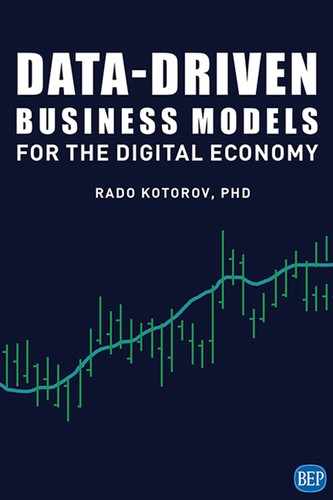Accumulation, 36–40
Activity-Based Costing (ABC) of business, 108
Adaptation as survival, 25
Adidas, 125–126
Aggregation, 36–38
Airbnb, 5, 57–58
Amazon, 32–33
Andreesen, Mark, 51
Asset density, 60
Asset-less business models, 6
advantages of, 63–64
challenges, 60
monetization opportunity matrix, 61–62
pricing, 63
scale and scope potential, 59–63
sharing business models, 64–65
short-term rental model, 61
Audible audiobook, 80
Ayres, Ian, 109
Belskie, Abram, 122
Benchmarking data products, 68
Bezos, Jeff, 36, 39
Big data patient profile, 109
Big granular data, 17
“The Black Swan” (Taleb), 52
Blockbuster, 27–29
Blockchain, 42–43
Bradenburger, Adam, 45
Buffet, Warren, 4
Business intelligence, 14
Business models, 22–23
Carr, Nicholas, 103
Change models
business models, 22–23
jobs, 20–22
market competition, 23–24
Check Point Cardio, 18–20
Christiaens, Stan, 131
Coase, Ronald, 40
Cognos, 45
Cohen, Gerald, 36
Cohen, Gerry, 36
Competitive dynamics matrix, 70–71
Complete aggregation, 36–38
Concentration, 36–40
Condition-based maintenance (CBM) models, 21, 93–94
Cooperation, 46
Cooperative competition, 45
Coopetition, 47
“Co-opetition: A Revolution Mindset that Combines Competition and Cooperation” (Bradenburger and Nalebuff), 45
Costless verification, 43
dApps, 43
Data as renewable resource, 15
Data assets monetization, 14–15
Data being an asset, 10–11
Data depth
analytics breadth vs., 112
dimensionality, 110–111
granularity, 111
Data disruption, 53–54
Data-driven business model, 4, 6, 43
Data-driven companies, 5
Data-driven decision style, 118
Data first approach, 15
Data innovation, 11–13
Data products
as business models, 67–70
competitive dynamics matrix, 70–71
monetization opportunity matrix, 73–74
product adoption and replacement dynamics, 70–73
scale and scope potential, 73–76
types of, 68
value to consumers, 76–77
Data R&D department, 14
Data scientists, 16
Decision-styles cultures and systems, 113–115
Dickinson, Robert Latou, 122
Digital data-driven company, 50
Digital economy
enterprise analytics stack, 115–119
market competition rules, 47
scale and scope, 31–33
Digital giants
companies as, 3
data-driven business model, 4
reasons for, 3
Digital growth, 33
Digital opportunities
Cambridge University research survey, 10–11
data assets monetization, 14–15
data being an asset, 10–11
data innovation, 11–13
Digital products, 79
Digital products business models, 6
Digital supplements
digital versions, 86–87
life cycle supplemental add-ons, 87–90
monetization opportunity matrix, 83–84
opportunity matrix for, 83–86
overview of, 79–83
plastic cards, 85–86
Digital versions, 81, 86–87
Dimensionality, 110–111
Disaggregate demand, 38–39
Disaggregation
process of, 40
socioeconomic effects, 40–43
Double-entry accounting, 107,
108, 110
Dresner, Howard, 14
Earning potential, 60
Ecosystem pull, 60
“The End of Averages: How We Succeed in a World That Values Sameness” (Rose), 123
Enterprise analytics stack, 115–119
Facebook, 5, 67
Financial intermediaries, 41–42
First mover advantage, 47–51
Fisher, Ronald Aylmer, 109
Flaw of averages, 123–124
Ford Model-T business model, 35, 38, 40
Franklin, Benjamin, 31
“Frequency of Use” dimension, 73–74
Game theory, 46
Gates, Bill, 36
“The Glass Cage: Automation and Us” (Carr), 103
Goethe, Johann Wolfgang von, 108
Google, 5, 49, 67, 127
Google maps, 74–75
Gosset, William Sealy, 109
Gould, Jay, 121, 122
Granularity, 111
Habit replacement loop, 71
Habit Stability dimension, 70
Harari, Yuval, 19
Heart-related sudden death, 18–20
“How the Mind Works” (Pinker), 126
Humby, Clive, 111
Jobs, 20–22
Kim, Min, 99
Kindle books, 80–81
Laney, Doug, 10
Lifecycle adaptation, 88
Life cycle monetization matrix, 88
Life cycle supplemental add-ons, 87–90
Lyft, 5, 6
Malthus, Thomas, 91
Man-less business models, 6
condition-based maintenance system, 93, 94
lack of accountability, 96
marginal rate of technical substitution, 92
meaningless automation, 103–104
monetization opportunity matrix, 101
opportunity matrix for, 100–103
overview of, 91–96
Product-as-a-Service, 97–98
rate of substation, 95
rate of technological evolution, 95
Service-as-a-Product, 99–100
Marginal rate of technical substitution, 92
Market competition, 23–24
Market competition rules
first mover advantage, 47–51
“The Winner Takes It All” (song), 51–53
Meaningless automation, 103–104
Microtrend-based management, 129–130
high-frequency trading operation, 131
key performance indicators, 128
motifs for operational monitoring, 131
strategic opportunities matrix, 129–130
Mill, James, 91
Miniaturization, 71
Monetization opportunity matrix, 61–62
asset-less business models, 61–62
data products, 73–74
digital supplements, 83–84
lifecycle adaptation, 88
man-less business model, 101
Motif intelligence, 127–128
Nalebuff, Barry, 45
“Need to Use” dimension, 71
Netflix, 28–29
NJTransit app, 76
North, Douglass, 41
Opportunity matrix, man-less business models, 100–103
Opportunity monetization matrix, 110–113
PaaS. See Product-as-a-Service
Pacioli, Luca, 107
Path dependency, 28
Personal health apps, 75
Physical assets, 4
accumulation of, 63
Physical assets-driven economy, 50
Pinker, Steven, 126
Pinterest, 5
Predictive data products, 68
Pricing, 63
“The Principles of Political Economy and Taxation” (Ricardo), 92
Product-as-a-Service (PaaS), 97–98
Product-less business models, 6
Reporting, 113
Ricardo, David, 91
Rose, Tod, 123
SaaP. See Service-as-a-Product
Savage, Sam, 123
Scale and scope
asset-less business models, 59–63
data products, 73–76
in digital economy, 31–33
digital growth, 33
in traditional economy, 29–30
Schauberger, Viktor, 128
Service-as-a-Product (SaaP), 99–100
Service-less business models, 6
Shape intelligence, 126, 127
Sharing economy model, 58
Smith, Adam, 40, 91
“Specificity” dimension, 73
Strategic opportunities matrix,
129–130
Subscription-based business
model, 28
Sudden cardio-related death, 18–20
“The Winner Takes It All” (song), 51–53
Traditional assets-driven company, 50
Traditional economics, 35
Traditional economy, scale and scope, 29–30
Transaction cost
affecting job market, 40–43
economics, 40
Type of asset, 60
Uber, 5, 6, 7, 41, 57–58
Van Dam, Stephen, 68
Walmart, 14
Walton, Sam, 14
WebFOCUS, 45
Weiner, Eric, 83
World Wide Web, 5
